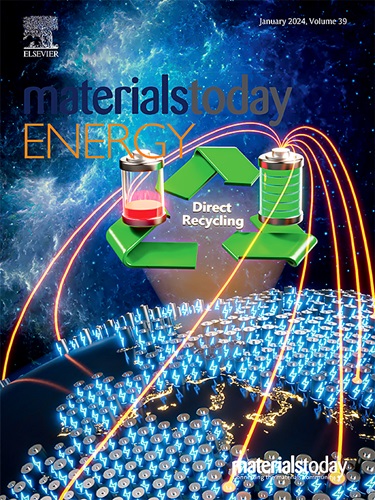Regulating pore structure of aramid nanofiber (ANF) separators for lithium–sulfur (Li–S) batteries
IF 8.6
2区 材料科学
Q1 CHEMISTRY, PHYSICAL
引用次数: 0
Abstract
Excellent ionic conductivity and mechanical robustness are significant for separators of Li–S batteries. Aramid nanofiber (ANF) has been widely used in separators due to their excellent mechanical properties and high-temperature resistance. However, pure ANF separator possesses a dense pore structure resulting from the closely intertwined nanofibrous network, leading to inferior ionic conductivity. Herein, we propose a strategy of inhibiting of hydrogen bonding (IHB) among nanofibers to regulate the pore structure of ANF separators via employing pore-forming agent, solvation, and differentiated drying methods. Notably, a graph theoretical methodology (structural GT) is introduced to analyze the percolating network of ANF separator, revealing that the higher average nodal connectivity, the more abundant and homogeneous porous structure and higher conductivity. Excitingly, the pore size and the ionic conductivity of ANF separator by supercritical carbon dioxide drying (S-ANFs) is 44 nm and 0.171 mS/cm, which is 5 times and 1.9 times higher than pure ANF separator, respectively. Moreover, the ANF separator is dimensionally stable under 200 °C, demonstrating its desirable security under extreme conditions. Finally, the half-cell equipped resultant S-ANFs exhibits outstanding cycling stability (566 mAh/g after 200 cycles at 0.5 C) and Coulombic efficiency (99.25%). This work provides an efficient strategy to regulate the pore structure of ANF separator.调节用于锂-硫(Li-S)电池的芳纶纳米纤维(ANF)隔膜的孔隙结构
优异的离子导电性和机械坚固性对锂-S 电池的隔膜具有重要意义。芳纶纳米纤维(ANF)具有优异的机械性能和耐高温性能,已被广泛应用于隔膜中。然而,由于纳米纤维网络紧密交织,纯 ANF 隔膜具有致密的孔隙结构,导致离子传导性较差。在此,我们提出了一种抑制纳米纤维间氢键(IHB)的策略,通过使用孔形成剂、溶解和不同的干燥方法来调节 ANF 分离剂的孔结构。值得注意的是,该研究引入了图论方法(结构GT)来分析ANF分离器的渗流网络,发现平均节点连通性越高,多孔结构越丰富、越均匀,导电率越高。令人振奋的是,超临界二氧化碳干燥(S-ANFs)的ANF分离器的孔径和离子电导率分别为44 nm和0.171 mS/cm,分别是纯ANF分离器的5倍和1.9倍。此外,ANF 分离器在 200 °C 下尺寸稳定,表明其在极端条件下具有理想的安全性。最后,配备半电池的 S-ANFs 具有出色的循环稳定性(在 0.5 ℃ 下循环 200 次后为 566 mAh/g)和库仑效率(99.25%)。这项工作为调节 ANF 分离器的孔结构提供了一种有效的策略。
本文章由计算机程序翻译,如有差异,请以英文原文为准。
求助全文
约1分钟内获得全文
求助全文
来源期刊

Materials Today Energy
Materials Science-Materials Science (miscellaneous)
CiteScore
15.10
自引率
7.50%
发文量
291
审稿时长
15 days
期刊介绍:
Materials Today Energy is a multi-disciplinary, rapid-publication journal focused on all aspects of materials for energy.
Materials Today Energy provides a forum for the discussion of high quality research that is helping define the inclusive, growing field of energy materials.
Part of the Materials Today family, Materials Today Energy offers authors rigorous peer review, rapid decisions, and high visibility. The editors welcome comprehensive articles, short communications and reviews on both theoretical and experimental work in relation to energy harvesting, conversion, storage and distribution, on topics including but not limited to:
-Solar energy conversion
-Hydrogen generation
-Photocatalysis
-Thermoelectric materials and devices
-Materials for nuclear energy applications
-Materials for Energy Storage
-Environment protection
-Sustainable and green materials
 求助内容:
求助内容: 应助结果提醒方式:
应助结果提醒方式:


